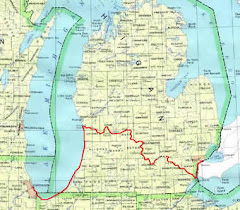Wikipedia: "The Maumee River is a river in northwestern Ohio and northeastern Indiana....It is formed at Fort Wayne,,,by the confluence of the St. Joseph and St. Mary's rivers, and meanders northeasterly for about 130 miles through an agricultural region of glacial moraines before flowing into Maumee Bay..." That St. Joseph River at Fort Wayne is not the same as the St. Joseph River that flows through South Bend and into Lake Michigan. Sometimes it is called the Little St. Joseph or St. Joseph of the Maumee. Like the St. Joseph of Lake Michigan, the Kalamazoo, the Grand, and River Raisin, its headwaters are in Hillsdale County as are the headwaters of the Tiffin River that flows into the Maumee at Defiance, Ohio. Got all that? More from Wikipedia: "The mouth of the river at Lake Erie is wide and supports considerable commercial traffic including oil, grain and coal. However, about 12 miles upstream, in the town of Maumee...the river becomes much shallower and supports only recreational navigation above that point." Valerie on the Maumee: "On the Maumee River we got a close-up view of winter because we were fighting our way upstream with our noses close to the bank...In spots the river was so low that our canoes scraped bottom on the rocks. We paddled over many rock ledges...places where my paddle was useless. Even the pole I used to push myself forward failed to find purchase on the flat rock bottom. It became a game of quick switching from paddle, to pole, and sometimes grabbing branches on shore to pull ourselves up the current..." Verlen on the Maumee: "The Maumee is deep and wide with lots of ocean going and industrial traffic through Toledo. Above the town off Maumee the river changes to shallow limestone ledges and riffles and occasional small rapids up to the town of Napolean. Then it remains a fairly consistent flat land, typical Midwest mud bank river right up to the heart of Fort Wayne." As they were paddling upstream beyond the city of Maumee and crossing under the I 475 and US 23 bridge they were just a short ways south of the site of the 1794 Battle of Fallen Timbers, the pivotal battle of the Northwest Indian Wars. Look it up. At Defiance the Hillsdale County-headwatered Tiffin River joins the Maumee, though that would not have impressed the Krugers much since it is kind of a dinky river and the fact it came from Michigan probably didn't excite them like it does me. The much larger Auglaize River comes in from the south at the same general location. In the mid-1800's the Miami and Erie Canal ran parallel to the Mamuee along the left (north) bank from Defiance to Toledo. The most that the Kruger's would have seen of it would have been remnants of the towpath now used for recreation. At Grand Rapids the Providence Metro park has a summertime operating section complete with water, canal boat and locks. The canal otherwise is under the pavement of Indiana 424 and US 24 all the way to Toledo. The Wabash and Erie Canal ran alongside the Maumee on the right (south) bank between Fort Wayne and Defiance. The coming of the railroads doomed the canals. A thing I notice about the Maumee is that they farm close to the river. There is not that nice border of trees and woods that I am used to seeing in following Michigan rivers. As they paddled into the east side of Fort Wayne the Krugers would have noticed riverside woods more like Michigan. It is called the "River Greenway". The Kruger's went up the Maumee in December. My satellite image overhead view of the Maumee looks like April. The trees are leafless and the fields have not yet been planted but the grass in lawns and golf courses is green. The paddle up the Maumee ends in Fort Wayne because that is where the Maumee begins, at the confluence of the Little St. Joseph and St. Mary's Rivers. Next: The Maumee-Wabash portage. |

Thursday, December 10, 2009
Following Verlen and Valerie-III-The Maumee
Subscribe to:
Post Comments (Atom)

No comments:
Post a Comment